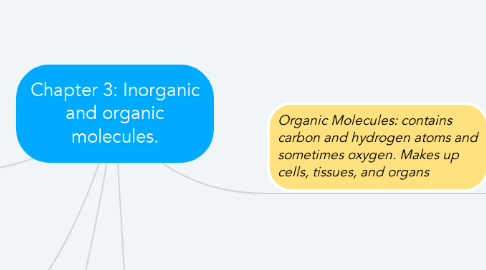
1. Hydrophobic: type of molecule that does not interact with water because it is nonpolar. Hydrophilic: type of molecule that interacts with water by dissolving or by forming hydrogen bonds with water molecules.
2. Monomers: small molecules that is a sub unit of polymer. Polymer: macro molecule consisting of covalently bonded monomers.
3. Dehydration synthesis reaction: chemical reaction resulting in a covalent bond with the loss of a water molecule. Hydrolysis reaction: splitting a compound by the addition of water.
4. Organic Molecules: contains carbon and hydrogen atoms and sometimes oxygen. Makes up cells, tissues, and organs
4.1. Organic molecules found in cells include; Carbohydrates, Lipids, Protein, and Nucleic Acid.
4.1.1. Carbohydrates: Class of organic compounds that include monasaccharides, disaccharides, and polysaccharides; present in foods as sugars, starch, and fiber.
4.1.1.1. Short term energy source
4.1.1.2. Carbohydrates exist as saccharide (sugar) monomers or polymers of saccharides.
4.1.1.3. Glucose: six carbon sugar that organisms break down as a source of energy during cellular respiration.
4.1.1.3.1. Glucose is a common monomer of carbohydrates polymers.
4.1.1.3.2. 2 Isomers; fructose and galactose
4.1.1.4. Monosaccharides (single sugar molecule): Simple sugar; a carbohydrate that cannot be broken down by hydrolysis.
4.1.1.4.1. Carbon backbone consisting of 3-7 carbons.
4.1.1.4.2. Ribose: sugar found in RNA. (have 5 carbon atoms)
4.1.1.4.3. Deoxyribose: sugar that is found in DNA and has one hydroxyl. (have 5 carbon atoms)
4.1.1.5. Disaccharide: sugar that contaisn 2 units of monosaccharide linked by dehydration synthesis reaction. 3 example; maltose, sucrose, and lactose.
4.1.1.5.1. Maltose conatins 2 glucose sub units. Brewing beer, the yeast breaks down the maltose and crates a process called feremntation.
4.1.1.5.2. Sucrose: aquired from sugar beets and sugar cane. Our body digests this into 2 monomers, fructose and glucose.
4.1.1.5.3. Lactose is found in milk. Contains glucose and galactose molecules
4.1.1.6. Polysaccharides: Polymer made from sugar monomers. The polysaccharides starch and glycogen are polymers of glucose monomers.
4.1.1.6.1. Larger than monosaccharides
4.1.1.6.2. can pass through the plasma membrane and are stored within a cell.
4.1.1.6.3. Starch: In plants, storage polysaccharide composed of glucose molecules join in a linear fashion with few side chains.
4.1.1.6.4. Glycogen: Storage polysaccharide found in animals; composed of glucose molecules joined in linear fashion but having numerous branches.
4.1.1.6.5. Cellulose: polysaccharide that is a major complex carbohydrates in plant cell walls. For humans this if fiber, for some animals they can't digest it.
4.1.1.6.6. Chitin: Strong but flexible nitrogen is polysaccharide found in the exoskeleton of arthopods.
4.1.2. Lipids: Class of organic compounds that tends to be soluble in non polar solvents; includes fats and oils.
4.1.2.1. Long term energy source
4.1.2.2. Are hydrophobic and insoluable
4.1.2.3. Fats and oils contain 2 subunit molecules; fatty acids and glycerol.
4.1.2.3.1. Fatty acids: Molecule that contains a hydrocarbon chain that ends with a carboxyl group.
4.1.2.3.2. Glycerol: Three carbon carbohydrates with 3 hydroxyl groups attached; a component of fats and oils
4.1.2.3.3. Triglycerides: Molecule composed of glycerol and 3 fatty acids that is the main component of fats and oils.
4.1.2.4. Phospholipids: Molecule that forms the phospolipid bilayer of plasma membranes. It has a polar, hydrophilic head bonded to 2 non polar, hydrophobic tails
4.1.2.5. Steroids: Types of lipid molecules having a complex of four carbon rings, cholesterol, estrogen, progesterone, and testoserone.
4.1.3. Protein: Molecule consisting one or more polypeptides; a micro nutrient in the diet that is digested to amino acids used by cells to synthesize cellular protein.
4.1.3.1. Functions of protein include; Support, Metabolism, Transport, Defense, Regulation, and Motion.
4.1.3.2. Monomers of proteins are amino acids. Amino Acids: Organic molecule composed of an amino group and an acid group; covalently bonds to produce peptide molecules
4.1.3.2.1. Peptides: 2 amino acids are joined by covalent bonds (peptide bonds; sharing electrons unevenly)
4.1.3.3. 4 levels of protein; primary, secondary, tertiary, and quaternary structures.
4.1.3.3.1. Denatured: Loss of an enzymes normal shape, so that it no longer functions. Caused by a less than optimal pH and temperature.
4.1.4. Nucleic Acid: Polymers of nucleotide. Both DNA and RNA are nucleic acids.
4.1.4.1. DNA: Nucleic acid polymer produced from covalent bonding of nucleotide monomers that contain the sugar deoxyribose; the gentic material of nearly all organisms.
4.1.4.2. RNA: Nucleic acid produced from covalent bonding of nucleotide monomers that contain sugar ribose. 3 major forms are messenger RNA, ribosomal RNA, and transfer RNA.
4.2. Cholesterol is an organic molecule and part of the cells outer membrane and a precursor to hormones. 2 types of cholesterol, HDL and LDL.
4.2.1. High Density lipoproteins (HDL): primarly on its way from the tissues to the liver. Reduces formation of plaque in arteries (considered the "good"one).
4.2.2. Low Density lipoproteins (LDL): carries cholesterol to the tissues, high levels of LDL contribute to plaque and heart disease (considered the "bad" one).
